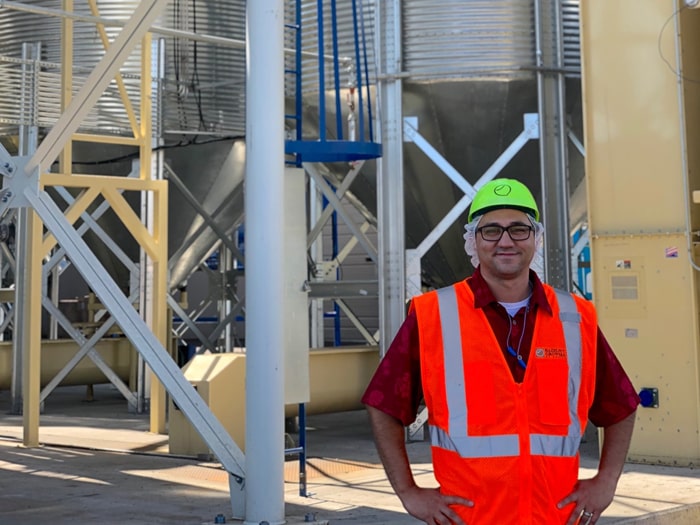Hazelnut Growers of Oregon, Latest News, Oregon Orchard
Adding Value to the Hazelnut Harvest
If you know anyone involved in the Oregon Hazelnut scene, you know the harvest is coming. Growers work year-round to ensure a healthy crop and abundant harvest, and Hazelnut Growers of Oregon is fully and uniquely prepared to add value to the lives of their growers.
As a farmer-owned co-op, the job of Hazelnut Growers of Oregon is to serve those growers by taking their crop, marketing it and selling it, adding value to it in the short and long term, and then returning that value to the growers. After many changes at HGO in the past couple of years, the co-op is fully motored in ways that are truly special to the industry. One of those ways is having experienced Plant Manager Jason Costa on board through the upcoming fall harvest.
When interviewing Jason, I had him take me through the process step by step to better understand how the co-op handles each piece of this very important puzzle – one that growers stake their livelihoods on. Wooden totes are delivered to growers beginning in late August or early September. Depending on the variety, some of the nuts have already started to drop of the trees.
“The rule of thumb for hazelnuts is to pick early and pick often”, Jason says. “The sooner we can get it in and dried down, the better. It’s pretty critical that we get it before the rain really hits.”
With that in mind, the co-op partners with wash plants throughout the region to ensure ease of drop-off after the grower has swept up their nuts and put them in the totes. There are now 12 of the wash plant receiving stations where the nuts are washed and tumbled to clean them and to remove sticks, stones, and leaves. At the wash plant, the nuts are then placed into a dryer and brought to 9% moisture and then brought to the processing facility in Donald, OR.
During harvest in 2018, HGO received about 40% more in the first 30 days of the season than in any previously recorded year. Jason mentioned that with such an influx of product and a brand-new facility still working out the kinks, it was at times stressful but really allowed him to troubleshoot and fine-tune the process for the 2019 season.
“It’s not typical to have to work out the bugs during harvest, but I thought it was fun,” he quips. “There were a lot of long days and a lot of long nights, but we were able to get through it. When things come that fast, you have to get it out of the silos and into processing. Outside, we have 4 silos that each store 2.5 million pounds – so that’s about 10 million pounds – but we’re receiving a lot more than 10 million pounds. We’ve got to get it out as fast as we’re putting it in.”
After experiencing a back-up during that initial influx, requiring the co-op to deal with overflow and secure outside storage quickly, they’re taking no chances this year. With almost triple the amount of additional storage lined up plus a few other contingency plans if the need arises, Jason is confident that receiving a large crop won’t be an issue. Not only that, but slack has been built into just about every other step of the process. Contractors were brought out over the summer to maximize the efficiency of all of the equipment, and vital machine spare parts are on hand and ready for use. Every step of the process within the plant has been tested, fine-tuned, and trusted contractors are available to respond to any emergent issues. “We took our equipment completely apart after last year’s season, cleaned it up, put it all back together, checked it all, tested it all, ran product through it for weeks, Jason reports. “It’s all been given the full shakedown.”
The wash plants and machinery are all working smoothly – what about staffing? “We have a trained crew that’s gone through a full season of it, they know our process, they can better adapt” to any issues that may come up. “This year we’ve extended our hours, we’re working through the weekends, and everything is functioning as it was intended.” In the 2018 season, the Donald plant was open for receiving from 6 a.m. – 9 p.m.; this year it’s open and staffed from 5 a.m. – 11 p.m. through the busiest parts of the season.
There is also frequent communication between the wash plants and the Donald processing facility to better anticipate any surges in delivery, to make any needed moisture adjustments to keep the product stable, and to make sure the growers are able to drop off their crop with ease. It’s important to the co-op that there is no hold up for the growers and that they can drop their hazelnuts off at will. “We now have a lot of additional totes to deliver to growers and for our work in process storage. We’re working around the rain, and we have to make sure we’re getting the nuts in fast for quality reasons. Through that, we have to support our growers as much as possible – they have enough stress and stuff to deal with on their end.”
Without going into too much detail, Jason also mentioned the other things that the co-op is doing to add value for their growers. Making hazelnuts as sustainable as possible, eliminating waste and researching more ways to use the bi-product, and finding ways to diversify locally are all on their radar. According to Jason, “It’s a good story that not a lot of nuts can tell.”
Interview and photos by Kaytee Horton



